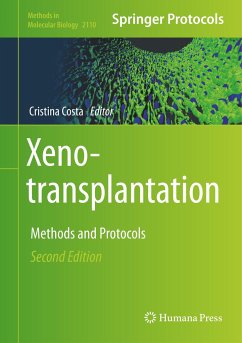
Cellular and Molecular Mechanisms of Chronic Rejection in Organ Transplantation
Versandkostenfrei!
Versandfertig in 6-10 Tagen
151,99 €
inkl. MwSt.

PAYBACK Punkte
76 °P sammeln!
Despite improvements in antirejection therapies, solid organ transplantation is hampered by chronic rejection, with around 70% of transplants being rejected within 10 years post-transplantation. Given the growing number of transplant candidates and the shortage of organ donors, finding a cure for chronic rejection is a priority in transplantation. Although chronic rejection studies have increased our knowledge of the subject over the years, the cellular and molecular processes involved in chronic rejection are still not fully understood.This volume covers the molecular and cellular aspects of ...
Despite improvements in antirejection therapies, solid organ transplantation is hampered by chronic rejection, with around 70% of transplants being rejected within 10 years post-transplantation. Given the growing number of transplant candidates and the shortage of organ donors, finding a cure for chronic rejection is a priority in transplantation. Although chronic rejection studies have increased our knowledge of the subject over the years, the cellular and molecular processes involved in chronic rejection are still not fully understood.
This volume covers the molecular and cellular aspects of the chronic rejection of both solid and composite allografts. It is divided into three parts:
Part I provides a comprehensive overview and mechanistic understanding of the cellular and molecular pathways underlying chronic rejection, as well as their potential in identifying novel biomarkers and developing targeted anti-chronic rejection strategies.Part II focuses on immune cells, non-immune cells, and extracellular molecules in the context of chronic rejection.Part III concentrates on shared and organ-specific (liver, face, kidney, lung) features as well as the latest therapeutic approaches in chronic rejection.
The book provides a comprehensive overview of the mechanisms and challenges involved, with the aim of inspiring the development of new therapies for chronic rejection.
This volume covers the molecular and cellular aspects of the chronic rejection of both solid and composite allografts. It is divided into three parts:
Part I provides a comprehensive overview and mechanistic understanding of the cellular and molecular pathways underlying chronic rejection, as well as their potential in identifying novel biomarkers and developing targeted anti-chronic rejection strategies.Part II focuses on immune cells, non-immune cells, and extracellular molecules in the context of chronic rejection.Part III concentrates on shared and organ-specific (liver, face, kidney, lung) features as well as the latest therapeutic approaches in chronic rejection.
The book provides a comprehensive overview of the mechanisms and challenges involved, with the aim of inspiring the development of new therapies for chronic rejection.












